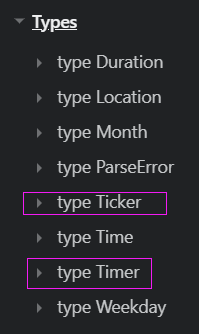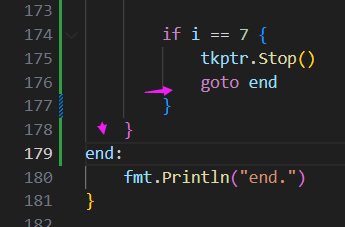Golang初学:time包,Ticker,Timer
go version go1.22.1 windows/amd64
Windows 11 + amd64
x86_64 x86_64 GNU/Linux
---
序章
package time
Package time provides functionality for measuring and displaying time.
测量、显示 时间。
本文展示 Ticker、Timer 的 基本使用。

type Ticker
源码:
// A Ticker holds a channel that delivers “ticks” of a clock
// at intervals.
type Ticker struct {
C <-chan Time // The channel on which the ticks are delivered.
r runtimeTimer
}通过 这里的 C(只读通道) 接收 tick 数据。
相关方法:
// 函数:创建
func NewTicker(d Duration) *Ticker
// 方法:
// 重置 间隔时间
func (t *Ticker) Reset(d Duration)
// 停止
func (t *Ticker) Stop()
创建
1、time.Tick 函数 不推荐。
示例:
tk := time.Tick(3 * time.Second)VS code 此时显示:
|
using time.Tick leaks the underlying ticker, consider using it only in endless functions, tests and the main package, and use time.NewTicker here (SA1015) |
2、time.NewTicker 推荐。
// 示例
tkptr := time.NewTicker(2 * time.Second)
// 函数签名
func NewTicker(d Duration) *Ticker
测试
建立一个 2秒 为周期的 Ticker,循环接收数据,在第5次时,重置(Reset)周期为 5m秒。
代码:
func testNewTicker() {
tkptr := time.NewTicker(2 * time.Second)
// 重要
defer tkptr.Stop()
for i := range [10]int{} {
tktime := <-tkptr.C
fmt.Println(i, tktime)
if i == 4 {
// 重置
fmt.Println("call Reset to 5s...")
tkptr.Reset(5 * time.Second)
}
//if i == 7 {
// tkptr.Stop()
//}
}
fmt.Println("end.")
}测试结果:
| 0 2024-05-13 21:17:29.5750291 +0800 CST m=+2.039318301 1 2024-05-13 21:17:31.5746698 +0800 CST m=+4.038959001 2 2024-05-13 21:17:33.564633 +0800 CST m=+6.028922201 3 2024-05-13 21:17:35.5707819 +0800 CST m=+8.035071101 4 2024-05-13 21:17:37.5620536 +0800 CST m=+10.026342801 call Reset to 5s... 5 2024-05-13 21:17:42.576125 +0800 CST m=+15.040414201 6 2024-05-13 21:17:47.5726813 +0800 CST m=+20.036970501 7 2024-05-13 21:17:52.5662796 +0800 CST m=+25.030568801 8 2024-05-13 21:17:57.5647188 +0800 CST m=+30.029008001 9 2024-05-13 21:18:02.5788418 +0800 CST m=+35.043131001 end. |
符合预期。
补充说明:
i == 7 的3行,测试了 Stop 方法。打开注释,程序会出现错误“fatal error: all goroutines are asleep - deadlock!”。
此时,应该在 Stop() 后 跳转(goto)到结束。

type Timer
源码:
type Timer struct {
C <-chan Time
r runtimeTimer
}也有一个 只读通道 C。
相关方法:
// 函数
// 周期到达后,执行函数 f
func AfterFunc(d Duration, f func()) *Timer
// 标准新建
func NewTimer(d Duration) *Timer
// 方法
// 重置
func (t *Timer) Reset(d Duration) bool
// 停止:在 到达前停止才有意义
func (t *Timer) Stop() bool
创建
// 示例
tptr := time.NewTimer(4 * time.Second)
测试
代码:
// NewTimer
func testTimer1() {
fmt.Println("start.", time.Now())
tptr := time.NewTimer(4 * time.Second)
defer tptr.Stop()
t1 := <-tptr.C
fmt.Println("t1=", t1)
// 再次调用 出错
// fatal error: all goroutines are asleep - deadlock!
// t2 := <-tptr.C
// fmt.Println(t2)
// Reset
// 重置后可以再使用
tptr.Reset(8 * time.Second)
t3 := <-tptr.C
fmt.Println("t3=", t3)
fmt.Println("end.")
}测试结果:
| start. 2024-05-13 21:47:31.2810254 +0800 CST m=+0.024694601 t1= 2024-05-13 21:47:35.2948188 +0800 CST m=+4.038488001 t3= 2024-05-13 21:47:43.3031721 +0800 CST m=+12.046841301 end. |
符合预期。
AfterFunc 的简单示例:
func testAfterFunc() {
tptr := time.AfterFunc(3*time.Second, func() {
fmt.Println("call f.", time.Now())
})
defer tptr.Stop()
// 4s 大于 tptr 的 3秒
fmt.Println("停止4s:")
// 两种方法 暂停
// 1. ok
// s4 := <-time.After(4 * time.Second)
// fmt.Println("s4=", s4)
// 2. ok
time.Sleep(4 * time.Second)
fmt.Println("end.")
}测试结果:
| start. 2024-05-13 21:50:46.199039 +0800 CST m=+0.025212501 停止4s: call f. 2024-05-13 21:50:49.2040232 +0800 CST m=+3.030196701 end. |
END.
ben发布于博客园
本文链接:
https://www.cnblogs.com/luo630/p/18190037
ben发布于博客园
参考资料
1、
ben发布于博客园
ben发布于博客园




【推荐】编程新体验,更懂你的AI,立即体验豆包MarsCode编程助手
【推荐】凌霞软件回馈社区,博客园 & 1Panel & Halo 联合会员上线
【推荐】抖音旗下AI助手豆包,你的智能百科全书,全免费不限次数
【推荐】轻量又高性能的 SSH 工具 IShell:AI 加持,快人一步